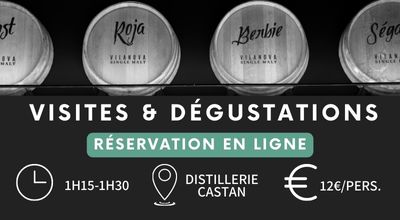Manufacturing
WHISKY PRODUCTION
Step 1
GROWING BARLEY
Malting barley is the grain used to make VILANOVA Single Malt and Single Cask whisky.
As a farm and distillery, the distillery uses its own production of malting barley. The barley is grown by the Castan family on family land in the commune of Villeneuve sur Vère, around the distillery.
For the production of malt whisky, the distillery uses barley rich in starch, which is used to obtain fermentable sugars and therefore alcohol.
Out of 160 hectares of land, 50 hectares are devoted to malting barley. We are in the process of converting to organic farming, and will be producing organic whiskies by the end of 2023.
HECTARES OF PLOTS IN TOTAL
HECTARES DEVOTED TO MALTING BARLEY
Step 2
MALTING
The barley grains are sent to a malting plant outside the distillery. Malting is the process by which malting barley is transformed into malt. It comprises two stages:
TREMPING
The barley undergoes several humidification and oxygenation phases. Damp barley is spread on malting floors, where a few millimeters of germination transforms the starch into whitish flour.
DRYING
The sprouted grain is transferred to the over for drying. Dried in hot air, it takes on soft, biscuity, toasted and roasted notes. Dried over a peat fire, it develops the smoky notes found after distillation.
Step 3
THE WATER SOURCE
The distillery uses natural water, drawn from a depth of 110 meters. In contact with more permeable soil and sedimentary limestone rock, the water penetrates the subsoil and becomes loaded with minerals, carbonates and sulfates. It then becomes alkaline and hard, giving Vilanova whisky its unique character and taste.
Step 4
BREWING
Brewing is the stage when, after reducing the malted grain to a coarse flour, it is macerated in spring water, heated to several successive degrees of temperature. The malt is cooked to release all its flavors. The sugars are extracted during the brewing process. The juices are separated from the floury grains by filtration.
Step 5
FERMENTATION
The juices ferment in stainless steel tanks for 5 days. Yeast is added to the juice to trigger fermentation of the sugars and transform them into alcohol. Once brewing is complete, the spent grains, cereal residues and flours are sent to local livestock farms to feed the animals.
step 6
DISTILLING
Distillation takes place in a 1929 red copper still, inherited from grandfather Gilbert Castan and modernized over the years. This legacy will enable third-generation Sébastien Castan to begin whisky production in 2010.
Here, the alcohol is extracted by low-pressure steam in copper vats, giving the whisky a fuller, rounder character. The Castan distillery’s stills produce supple spirits, giving Vilanova Whiskies a true signature.
Step 7
AGEING
Ageing is one of the essential stages in the creation of a quality whisky. The whisky is enriched by the aromas of the wood and the character of the barrel in which it is stored. It is also the wood that gives the whisky its amber color. The coloring comes naturally from the wood.
- AGED IN FRENCH OAK EX-WHITE WINE BARRELS 75%
- EX-RED WINE BARREL AGING, IN FRENCH OAK 50%
- EX-BOURBON BARREL AGING, IN AMERICAN OAK 25%



